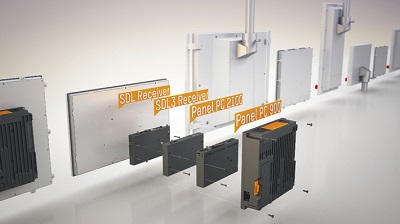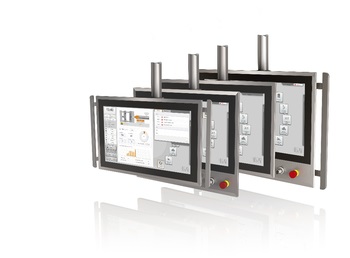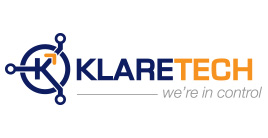Modular Industrial PC's and Panel PC's
Erasing the boundaries

The days of classic series-produced machines that manufactured the same exact product for 20 years have been over for quite some time now. As we move into the future, production will require ever-increasing levels of machine and system flexibility – flexibility that can be achieved thanks to modular panel components developed by B&R.
The machine manufacturing industry is under a great deal of pressure. On the one hand, a single machine must be able to manufacture individualized products without having to undergo time-consuming retooling work; on the other hand, the machine cannot become outdated after just a few short years. "Modern industrial production is characterized by short product cycles and increasing product customization," explains Raimund Ruf, business manager of HMI at B&R. "This means that batch sizes of 1 are no longer only a feature of the automotive industry." With this in mind, his team has developed a modular platform strategy that offers machine builders one-of-a-kind flexibility.
Unlimited scalability
Put simply, B&R has completely severed industrial panels from the processing components. "The main idea is that any panel can be combined with any processor," explains Ruf. As a result, machine manufacturers only have to integrate a panel once. In this way, it is the individual panel components that are selected – the processor, memory, etc. – that determine the performance class of the system.
This new approach is based around the Automation Panel, a series of display panels available in a wide variety of sizes and aspect ratios. When combined with a modular PC unit, the panels become powerful Panel PCs whose performance can be fine-tuned to actual demands. From single-core Celeron to quad-core Core i7 processors, the entire performance range is covered. Any necessary interfaces (e.g. POWERLINK or serial) can be configured as needed using plug-in cards.
Easy to upgrade
Performing maintenance or upgrading individual components has also become must easier. If a new application or HMI system requires more computing power, the Panel PC unit can simply be replaced by one with increased performance. The only technical expertise required is the ability to remove 6 screws. And with the robust connector, there are no cables to install or remove. Furthermore, if all relevant application data is stored on a CFast card, the new Panel PC can be brought back online immediately.
"This new building block principle also takes into account the fact that PCs and display technology have different life cycles," explains Ruf. It used to be the case that the entire unit – the PC and the panel – had to be replaced if the computing power was no longer sufficient or upgrades were necessary. "Our new approach opens up significant savings for machine builders and end users, especially since it allows customized panels to be used over many processor generations."
Maintenance-free industrial PCs
Nearly all of the PC modules are fanless. Combined with CFast cards and SSD drive technology, it is possible to install an industrial PC whose lack of rotating parts makes it maintenance-free. This further eliminates the expensive and time-consuming work involved in replacing worn parts. "The entire cooling system for the Panel PC 900 received a complete overhaul," explains Ruf. "In order to achieve the best possible convective heat transfer, we performed extensive evaluations based on simulation models and implemented heat pipes." This allows even the powerful Core i7 3517UE processor to be used at ambient temperatures up to 50°C without a fan – under full load!
The cooling system for quad-core processors has also been optimized, with fans directing air through integrated cooling fins to guarantee smooth operation even on high-end systems. In addition, B&R sought out only those components that offered the highest levels of reliability, including the hard drives, circuit boards and housing. These components have been designed specifically for use in industrial environments, can withstand high ambient temperatures and will continue to be available for many years to come.
There is even potential for savings when it comes to managing stock. Since Automation Panel systems utilize the same base technology for panels connected via SDL/DVI as they do for Panel PCs, machine manufacturers can respond immediately to changing customer demands if the necessary components are already in stock. All-in-one devices not only face higher cost levels here, but also an increased amount of work.
Access from afar
All Panel PC 900 devices with Core i-series processors support Intel's Active Management Technology (AMT) – a feature of Intel's vPro technology – to provide out-of-band management. This allows PC systems to be serviced remotely at a level much closer to the hardware, regardless of which operating system is being used.
AMT makes it possible to read status information, change BIOS configurations and switch the PC on and off – all remotely. A remote boot option is also available. Because access takes place independently of the operating system, it is possible to reboot the system remotely even if the operating system is no longer responding. This is especially useful for PC systems being operated without on-site personnel, as is often the case with traffic management systems, for example.
AMT also provides additional remote service and troubleshooting options. This allows every bit of information about the PC components being used to be read – including the type of processor. The only requirement is that the PC is turned on and connected to a network. In addition, an event log provides detailed information about system processes running on the PC (e.g. "Starting operating system boot process").
Displays and touch screens for every requirement
Available in a wide range of designs, Automation Panels are perfectly suited to meet all the requirements of today's advanced industrial HMI applications. For example, widescreen variants are available in sizes up to 24" with Full HD resolution. At the same time, applications requiring compatibility to existing systems can take advantage of 4:3 panels with analog resistive touch screens. This makes it possible to continue using HMI applications at their current resolution while upgrading to the latest PC technology without having to modify the software a single bit. And since all touch screens can be operated with gloves, they are the perfect choice for withstanding even the toughest industrial environments.
Swing arm systems are becoming more and more prevalent as a way to optimize operator guidance on machines. B&R meets this demand by offering Automation Panels and Panel PCs for many different types of swing arm systems. This doesn't just tie into the different display sizes and formats; all variants are designed with IP65 protection, available in portrait format and ideal for use in hygienic applications. An additional panel component – the Smart Display Link 3 receiver – makes using panels in swing arm systems even easier. This device allows panels to be situated up to 100 meters from the Panel PC or Industrial PC when using conventional Category 6 or 7 Ethernet cables. And thanks to the slim RJ45 connector, there is no problem running the cable through the narrow swing arm conduit.


RFID for maximum operational security
Swing arm devices are available with a wide array of optional operating elements, with buttons, selector/key switches and E-stop layouts adaptable to customer needs. Thanks to an integrated RFID reader, individual access rights can be assigned to anyone from service engineers to system operators. Jotting down passwords on small scraps of paper has been relegated to the past – right where it belongs. A wide range of display sizes and formats is available, including a swing arm device in portrait format.
"An important advancement regarding safety has certainly been made possible with the introduction of multi-touch displays to industrial environments," says Ruf. Potentially critical situations – starting a process or motor, for example – can be made much safer using two-hand control. In this way, the operator must confirm a command with the other hand in order for the action to be executed. This eliminates the possibility of accidental activation.
Extensive operator guidance
Of course, multi-touch displays also allow the gestures that are familiar to us from consumer devices. For example, swipe gestures can be used to scroll or change pages, while 2-finger gestures can be used to zoom in and out. Together with large widescreen displays, this results in entirely new possibilities for operator guidance. Not only is it possible to display more information on-screen, operating personnel can also view data sheets or video guides without covering up information relating to the current status of the machine.


